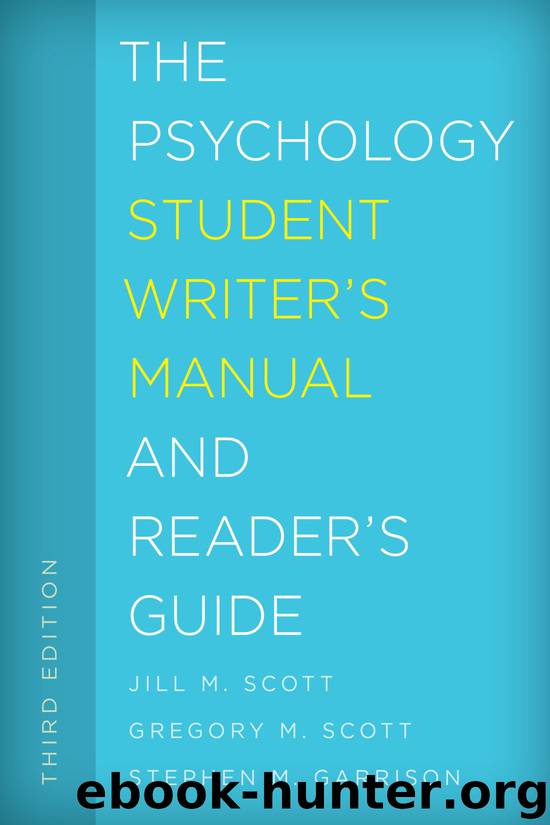The Psychology Student Writer's Manual and Reader's Guide by Jill M. Scott Gregory M. Scott Stephen M. Garrison & Gregory M. Scott & Stephen M. Garrison

Author:Jill M. Scott,Gregory M. Scott,Stephen M. Garrison & Gregory M. Scott & Stephen M. Garrison
Language: eng
Format: epub
Publisher: Rowman & Littlefield Publishing Group, Inc.
Read & Write 3.4
Compile a Usable Bibliography
Select a topic of your choice and construct a bibliography of published sources in APA style, including ten different types of sources (journal articles, books, book reviews, online sources, etc.).
3.5AVOID PLAGIARISM
Plagiarism is the use of someone else’s words or ideas without proper credit. Although some plagiarism is deliberate, produced by writers who understand that they are guilty of a kind of academic thievery, much of it is unconscious, committed by writers who are not aware of the varieties of plagiarism or who are careless in recording their borrowings from sources. Plagiarism includes:
•Quoting directly without acknowledging the source
•Paraphrasing without acknowledging the source
•Constructing a paraphrase that closely resembles the original in language and syntax
You want to use your source material as effectively as possible. This will sometimes mean that you should quote from a source directly, whereas at other times you will want to express such information in your own words. At all times, you should work to integrate the source material skillfully into the flow of your written argument.
When to Quote
You should quote directly from a source when the original language is distinctive enough to enhance your argument, or when rewording the passage would lessen its impact. In the interest of fairness, you should also quote a passage to which you will take exception. Rarely, however, should you quote a source at great length (longer than two or three paragraphs). Nor should your paper, or any substantial section of it, be merely a string of quoted passages. The more language you take from the writings of others, the more the quotations will disrupt the rhetorical flow of your own words. Too much quoting creates a choppy patchwork of varying styles and borrowed purposes in which your sense of your own control over your material is lost.
Quotations in Relation to Your Writing
When you do use a quotation, make sure that you insert it skillfully. According to the sixth edition of the Publication Manual of the APA (2010), quotations of fewer than 40 words should generally be integrated into the text and set off with quotation marks:
“In the last analysis,” Mary Lewis argued in 2016, “we cannot afford not to embark on a radical program of treatment reform” (p. 12).
A quotation of 40 words or longer should be formatted as a block quotation; it should begin on a new line, be indented in its entirety from the left margin, and not be enclosed in quotation marks.
Llewellyn’s outlook for the solution to the problem of the nation’s over-supply of qualified research scientists is anything but optimistic:
If the trend in grantsssing graduate degrees in research psychology continues, the cost of doing nothing may be too high. Most good positions in research psychology are tenure-track university posts. Funding declines and elevated college costs have forced cutbacks in new jobs across the country. The three-year period from 2012 to 2015 shows an annual increase in under-employed researchers of roughly twenty percent. Such an upward trend for a sustained period of time would eventually reduce the supply of well qualified scientists.
Download
This site does not store any files on its server. We only index and link to content provided by other sites. Please contact the content providers to delete copyright contents if any and email us, we'll remove relevant links or contents immediately.
Rewire Your Anxious Brain by Catherine M. Pittman(17581)
Talking to Strangers by Malcolm Gladwell(11861)
The Art of Thinking Clearly by Rolf Dobelli(8836)
Mindhunter: Inside the FBI's Elite Serial Crime Unit by John E. Douglas & Mark Olshaker(7827)
Becoming Supernatural by Dr. Joe Dispenza(7099)
Change Your Questions, Change Your Life by Marilee Adams(6636)
Nudge - Improving Decisions about Health, Wealth, and Happiness by Thaler Sunstein(6629)
The Road Less Traveled by M. Scott Peck(6627)
The Lost Art of Listening by Michael P. Nichols(6462)
Enlightenment Now: The Case for Reason, Science, Humanism, and Progress by Steven Pinker(6402)
Win Bigly by Scott Adams(6306)
Mastermind: How to Think Like Sherlock Holmes by Maria Konnikova(6224)
The Way of Zen by Alan W. Watts(5787)
Daring Greatly by Brene Brown(5636)
Grit by Angela Duckworth(4728)
Big Magic: Creative Living Beyond Fear by Elizabeth Gilbert(4717)
Men In Love by Nancy Friday(4314)
Flow by Mihaly Csikszentmihalyi(4047)
The Four Tendencies by Gretchen Rubin(4017)
